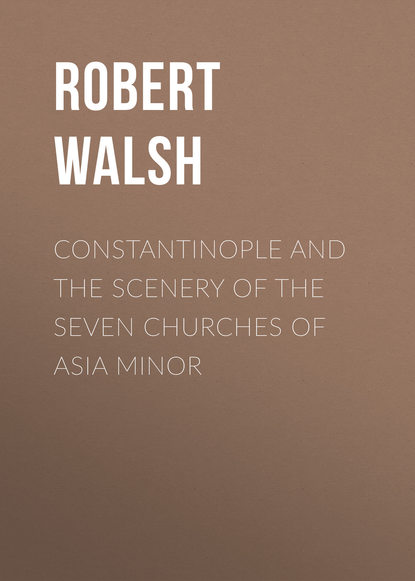 Полная версия
Полная версияConstantinople and the Scenery of the Seven Churches of Asia Minor
THE MOSQUE OF YENI JAMI
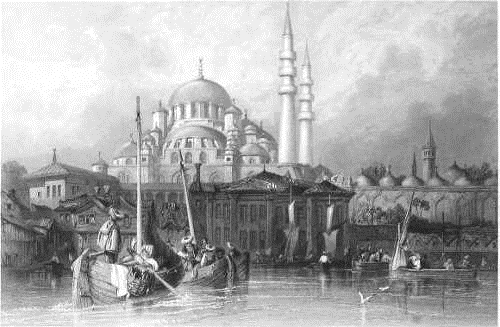
T. Allom. P. Lightfoot.
This is called Yeni, or “new,” to distinguish it from those of more ancient structure. It is justly remarked by writers, that no people have selected such excellent sites for their religious houses as the Turks: they are generally seen crowning the summits of hills, and having every advantage of display for their architectural ornaments. This, however, is an exception. It stands near the centre of the Golden Horn, in a low part of the city, but is very conspicuous from its situation. It swells, as it were, from the water’s edge, forming a mountain of edifices. The only place where Turkish beggars are seen is the area or vicinity of a mosque, and even here very few obtrude themselves; forming a strong contrast to the multitudes that beset houses of Christian worship. Those who with us are disabled by age or sickness, are in Turkey supported by their masters, either because they are slaves, or because the charity of the Osmanli will not suffer his brother to want. The few who ask alms are idiots, a respected and privileged class; or Arabs, who bear about standards, which they affirm were the same as those under which their ancestors propagated the faith of the Prophet. In the evening, you are met by a man who proffers you a candle, an orange, or a melon, and you purchase it for double its value: so, a Turkish beggar sells, but receives no alms. In the populous region about this mosque, such persons are more usually met than elsewhere. Immediately below is a great scala, or landing-place, which is constantly crowded with caïques of all shapes and sizes, and forms an animated scene of bustle and activity. Leading to it is one of the aqueducts which convey water for the necessary ablutions of the faithful, when they attend the call of the muezzin to assemble at the hour of prayer.
BALUK HANA AND METHOD OF FISHING FOR THE RED MULLET.
AT THIS SPOT, STATE CRIMINALS ARE THROWN INTO THE BOSPHORUS FROM THE SERAGLIO
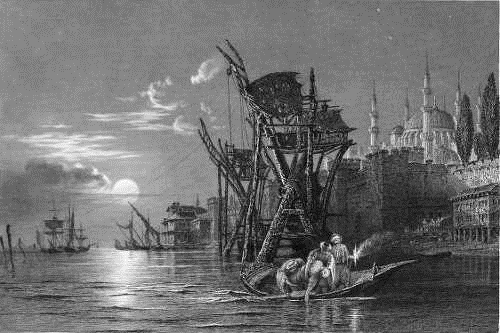
T. Allom. F. J. Havell.
This literally means the house or edifice of fish. It is one of the numerous stages erected on many parts of the Bosphorus, from the Euxine to the Propontis, to arrest the numerous shoals of fish that are migrating from sea to sea through this channel. It is formed in this manner:—posts are driven into the water at a short distance from the shore, with which they sometimes communicate by a platform; these are strengthened by cross-posts, forming a ladder by which the platform is ascended. On the summit is raised a shed, ten or twelve feet above the surface, over which is drawn a rude covering of mats. Below, is an enclosed area, marked by piles, into which the passing fish enter, and cannot again make their way out. A man continually on the watch in the shed gives notice of this to the fishermen on the shore, when the nets are drawn, and the whole shoal generally captured.
The progress of these shoals is frequently marked by flights of gulls and other aquatic birds, which, when the net is drawn, rush down among the fishermen, and fearlessly and clamorously demand their share, which is never withheld from them. These wild fowl are so tame by use and impunity, that they are sometimes seen disputing with a Turk for a particular fish; and the man almost always yields to the bird.
The fish usually taken in these nets are of various sizes, and many peculiar to this region. The largest is the xiphias, or sword-fish, sometimes attaining the length of six or eight feet in the body, and a circumference of three or four. From its snout is projected a flat horn, a yard or more in length, exactly resembling a Highland broad-sword, from whence the fish derives its name. Its flesh is red, and when exposed for sale in the market, a junk of it might be mistaken for a round of beef. The next in size is the thunny; the various kinds of scomber, down to the size of small mackerel fry; the lufer and the kephālos, called so by the Greeks, from the size of its head. Among the flatfish is a species of turbot, of excellent quality, covered with hard cartilaginous knobby scales like a bossy shield, and thence called by the Turks, kalchan, or the buckler-fish. These, and an infinite variety of others, crowd the waters in incredible quantities, for nine months in the year; and the boats engaged in taking them are so numerous, as to stretch from side to side of the strait in such a way as to bridge the current; and the eagerness to take them is so great, that all ranks indulge in it, from the sultan to the hummal. Mustapha, the brother of Mahmoud, was engaged in it when he heard of the insurrection in favour of Selim−and he left his fishing, to strangle his cousin. The present sultan is so fond of it, that one of his apartments at Beshiktash has a trap-door over the water, from whence he often angles. Nor is this amusement confined to the day: by night the waters are covered with many lights, which float in various mazes, and form picturesque objects round the islands of the Propontis. A brazier is projected from the prow, in which a glowing fire is kept up continually, and the fish, attracted by the flame, hover about like moths round a taper, and are harpooned as they approach the boat; when the water is disturbed or muddy, a small quantity of oil is cast upon the surface, which renders it transparent and every object distinct.10
The Baluk hané, represented in the illustration, is distinguished by another circumstance. It is situated on the sea of Marmora, below the walls of the seraglio, and above it are seen, towering, the dome and minarets of the mosque of Achmet. The torch in the caïque is not for the purpose of fishing, but for a very different and dismal one. When sentence of death is passed on an inmate of the seraglio, he is brought to the Capi Arasi, a space so called between the second and third gates, and there arrested “within the doors,” as it is ordered. Here the executioners reside who despatch him; and the strangled or headless man is brought down to a kiosk on the sea-wall, from whence a window opens on the water. From hence, in the dead of night, the body is consigned to a caïque in waiting, which rows to a little distance, and consigns it to its watery grave. The sullen plash is sometimes accompanied by a discharge of a gun on a wharf not far distant, and the silence of the night is broken by a solemn sound which comes booming over the water as the knell of the departed. So frequent have these executions been, that a passing boat to ships in the harbour, at this place, might always expect to see at midnight the gleam of a torch attendant on this watery funeral. There is something insuperably revolting in the proximity of the places. The fish are said to be attracted by such bait, and are thus fed and fattened on human flesh in this aquatic charnel-house.
THE GREAT BAZAAR, CONSTANTINOPLE
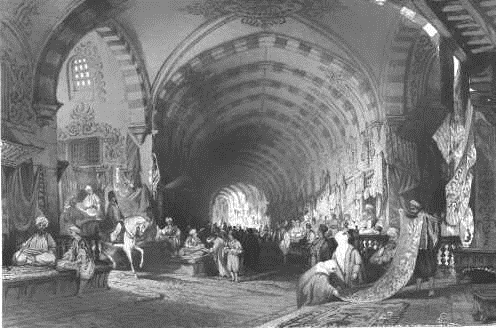
T. Allom. J. W. Lowry.
Markets at Constantinople, where various commodities are vended, are properly distinguished by three names−Bezesteen contained shops where cloth was sold; Bazaar was an open market where eatables were exposed for sale; thus Et-Bazaar, and Baluk-Bazaar, are the flesh and fish markets; and Charschey was a covered street, with stalls or shops on each side, where all kinds of manufactured wares were to be met with. These original designations, however, have merged into one, and bazaar is a general name by which every market is denominated.
The Great Bazaar, or Charschey, was erected by Mohamed II. when he took possession of Constantinople, and began to change its character from a European to an Asiatic city, by introducing the edifices and usages of the East. It was afterwards re-edified by his successors, and its parts distinguished by Eski and Yeni, the Old and the New Bazaar. They now consist of long avenues covered over with lofty arches of brick, lighted by apertures in the roof, and branching off in various directions. The ceilings of the vaults, and other parts of the walls, are painted with various flowers and devices. On each side of the passage are counters, or stalls, ranged along, leaving a wide way between. On the counter of each stall the merchant sits, generally smoking a chibouque, or narghillai, with his crossed legs drawn under him. If he be distinguished by a calpac, or inverted cone, upon his head, or a large snow-white turban, he is either an Armenian or a Turk; so he quietly abides his time, and suffers you to pass with imperturbable gravity, seldom condescending to ask your custom. If he wear a cross-barred handkerchief, twisted round the crown of a hat, or a coarse muslin wound about a red fez, he is either a Jew or a Greek, and is as importunate with you to buy as a salesman in Monmouth-street. Behind him, his larger wares are ranged against the walls, and his smaller in clumsy glass-cases beside him on the counter, where all articles are confounded in a heap. In his rear is generally a low door, opening into a small room in the thickness of the walls, where his unexposed goods are stored.
These edifices, filled with light and inflammable goods, are liable to danger from the constant fires which occur at Constantinople, though they are in some measure protected by their construction, and the thickness of the walls. When fires have penetrated, they have been attended with the most awful consequences. It has happened that both ends of the covered way have been blazing at once, and all egress prevented to the crowd within, and hundreds have miserably perished, either consumed or suffocated in these vaults of fire. In order to guard against this, no smoking, or light of any kind, is allowed: notwithstanding this, the inveterate propensity of the Turk is not to be controlled, and, relying on his unalterable destiny, he is often seen with the glowing bowl of his pipe thrust among the inflammable materials of his counter. Every evening at sunset, the bazaar is closed with iron gates, and the merchants having locked up their wares behind certain partitions drawn before them, are seen wending their way in groups to the several quarters of the city in which each class is located−the Jew to Galata, the Greek to the Fanar, the Armenian to Ypsomathia, and the Turk to various quarters.
Under cover at all times, and protected from wind, rain, and sun, this bazaar is the resort of crowds every day and all day long. In the heats of summer it is particularly agreeable. People escape from the burning atmosphere, and an exposed unsheltered street, to this retreat. It then resembles a subterranean city, crowded with a busy population of many thousand persons, bustling, buying, and selling in the cool and dim twilight. But the fair sex form by far the majority. It seems a privileged place, where the ordinary distinction of sect or caste is laid aside, and the Turk, Frank, and Raya, all mix and chat and bargain together without restraint; and it seems the only place where the pride and taciturnity of the Osmanli is laid aside. At the entrance are crowds of poor Jews, who proffer their services to conduct you to what you want, and carry home what you purchase.
The first attraction is generally a perfume-stall. Here attar of roses, essence of lemon, extract of jasmine, pastiles of odoriferous gums, which, when ignited, fill the air with their aromatic scent, are presented to your choice. The last are particularly recommended, as used by the ladies of the seraglio, who burn them in their pipe-bowls. But of all the singular perfumes presented to you, are rats’-tails. An animal of this species is endued with musky secretions, and its tail yields a strong scent, which it retains for an indefinite term. All these and many more odoriferous delicacies, which a Turk prizes, are presented to you; and to induce you to buy, your hands, lips, hair, whiskers, and cravat, are bedewed with them all, and you go forth redolent with animal and vegetable odours. The next attraction is the shoe-bazaar. Here the varied display of imeh and papoosh, boots and slippers, is very dazzling: a Turk never wears a boot without a slipper. The first are red or yellow morocco, without soles, but sewed below into a pointed bag, into which the foot is first forced; and then, with the boot, into the slipper. The gait of both men and women, thus encumbered, is singularly awkward and helpless. The feet scrape the ground, and the sole of the slipper, which scarcely adheres to the point of the toe, is dragged along, continually flapping against the heel. These characteristic parts of Oriental dress are the particular objects of Frank purchasers. The slippers are made of all materials, and braided with all kinds of embroidery in gold and silver, and often ornamented with pearls and precious stones. In this department are found drinking-cups of untanned leather, and mirrors with morocco frames.
But by far the most attractive display is the pipe department, and the variety of chiboques. It is here the fancy of a Turk luxuriates, and loves to exhibit itself with a dexterity shown in nothing else. The implement consists of three separate parts−tube, bowl, and mouth-piece—in each of which there is an endless variety of shape, size, and material. The most favourite wood for the first is cherry-tree brought from Trebisond, rose-wood and jasmine, sometimes extending to the length of ten or twelve feet. When you choose your rod, the artist pierces it with the aid of his toe, a member he uses with more skill than his finger. The bowl is a red earth, found and manufactured at Burgaz, highly gilt and polished. The mouth-piece is generally amber, imported by Armenians from the Baltic. This is prized above all materials, not only for its beauty, but for its qualities. It is supposed to be unsusceptible of the contagion of the plague; and when that disease is raging, and every man shrinks from contact with his neighbour, the amber chiboque passes from mouth to mouth without any apprehension of pestilent saliva. A pipe is sometimes ornamented with precious stones, and, with the tobacco-bag glittering with spangles, varies in price from 10 to 1000 piastres, according to the workmanship. Besides these and other articles peculiarly Turkish, clothing, stuffs, carpets, shawls, &c. are displayed, and among them the highly-prized manufactures of Manchester.
THE ATMEIDAN, OR HIPPODROME; AND MOSQUE OF ACHMET.
WITH THE COLUMN OF CONSTANTINE AND EGYPTIAN OBELISK
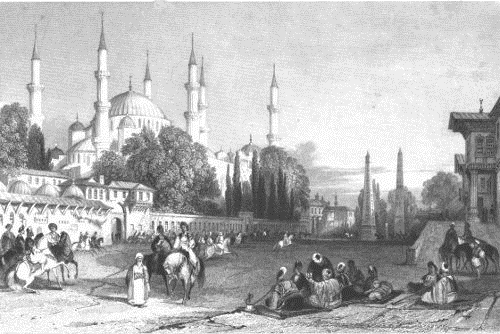
T. Allom. S Lacey.
The word meidan signifies “a place,” and corresponds with the sense in which we use the latter term in our towns. There are many so called in Constantinople, but the most distinguished is the Atmeidan, or “Place of the Horse.” It was, under the Greek empire, called Hippodrome, which implies a horse-course. The Turks applied it to the same purpose, and translated the Greek appellation into their own language. It is described in the most gorgeous manner by the writers of the lower empire, as ornamented with marble colonnades, and surrounded by seats like an amphitheatre, where the courses were observed by the spectators. These things have disappeared under the Turks, and it is now a naked oblong area, with a very ruinous and neglected aspect. It has, however, still its attractions. It is almost the only open and airy public space within the walls of the city, and it is the only spot where the very few ornaments of this great capital, now extant, are to be seen in their original site and form.
The present area is an irregular quadrangle, about 260 yards long, and 150 wide. It is bounded on one side by the mosque of Sultan Achmet, from which it is separated only by an open screen, and from it this beautiful edifice, with its six elegant minarets, appears to the greatest advantage. On the others, by large but mean edifices, one of which is the menagerie of the Turkish empire. Among the gifts expected from the pasha of a distant province, are specimens of its wild animals; and lions, tigers, and other beasts are here enclosed and exhibited, as formerly in the tower of London. Among the animals here in the time of Busbequius, was an extraordinary elephant, which, he affirmed, “could dance and play ball.” They are not confined to cages, but allowed to walk about in large caverns, where the solitary magnificence of the animal would be strikingly exhibited, were it not that the foul odour exhaled from putrid offals, on which they feed, repels a stranger with insuperable disgust.
Down the centre are seen the splendid remains of the Greek empire. The first is the granite obelisk, still in high preservation, brought from the Thebaïd to Rome, and from thence to ornament the new city of Constantine. It is supported on brazen globes, resting on a sculptured pedestal bearing an inscription implying that it was erected by Theodosius. On one face is sculptured the machines by which the obelisk was raised to its present site, and is a curious display of the mechanical powers at that time in use. A singular circumstance occurred at its erection, which has since that time furnished an extraordinary auxiliary to mechanical powers. When the ponderous block was raised as high as the combination of cords and pulleys could draw it, it was found to want one inch of elevation to place it on the pedestal. The emperor and all the spectators supposed the labour and expense lost, and the case hopeless; when the ingenious artist who had undertaken to raise it, caused water to be thrown upon the cords by which the obelisk was suspended: an immediate contraction of the fibres took place, the cords shortened, and the immense weight was quietly raised to its place without any other mechanical Contrivance. Another is that called the Colossus: it was once covered with dense brass plates; and a Greek couplet on the pedestal, described what it formerly was, and the reason of its name−
“A brazen wonder of colossal size,Which Rhodes could boast−lo! here is seen to rise.”But the Turks have belied the inscription. They have carefully picked off the brass plates for their trifling value, and left nothing but an unsightly shaft of masonry and mortar in which they were embedded. But the most valuable remnant of antiquity existing here, or perhaps in any other country, is a colossal brazen twisted serpent, which once had a triple head, from whence issued wine, water, and milk. It had formed a shrine at Delphi, on which were placed the golden tripod and patera presented to the god of the temple by the Greeks, to commemorate the victories in the Persian war, and was removed to Constantinople as one of the most valuable remains of ancient art and historic recollection. It was so highly prized, that the Turks considered it as the talisman that protected the Greek empire; and when Mohammed entered the devoted capital in triumph, he struck off one of the heads with his battle-axe, to destroy, as it were, the delusion. It is now a truncated stump, and constantly battered with stones by the Turks, as if their ancient superstition and prejudice yet existed.
The illustration represents the present state of the Hippodrome, and gives an idea of its ancient use. The Turks have no trials of equestrian skill like those of the Greeks; but here they usually exercise their horses, and throw the djerid, a wooden pointless spear, which they cast to a distance, and catch as it recoils from the ground, with considerable dexterity. On one side is the palace of Ibrahim Pasha, now the head-quarters of the cavalry staff, who are seen among the equestrians.
THE MOSQUE OF SANTA SOPHIA AND FOUNTAIN OF THE SERAGLIO
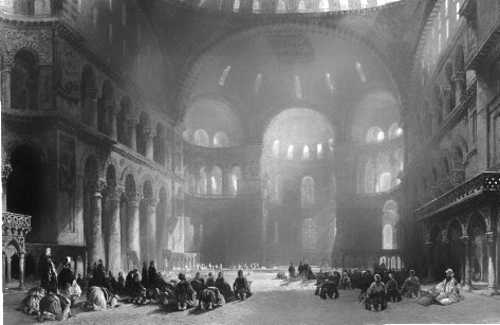
Drawn by Leitch. Engraved by J. Sands.
When Constantine dedicated his great city to Christ, he thought it right to erect in it a suitable edifice for Christian worship, on a scale of magnificence commensurate with his capital; he therefore built one of the first public temples, to the new faith, that had been permitted since the destruction of Christian churches and the extirpation of their congregations by the decree of Diocletian, and he dedicated it to the Ἁγία σοφία, “the Holy and Eternal Wisdom of God,” as manifested in his blessed Son. During the discordant schisms which unhappily rent the Christian church, this splendid structure was reduced to a state of ruin, and it was reserved for the emperor Justinian to re-edify it. He had the old foundations cleared away, and purchased, at a considerable expense, a larger area on which to erect it. To obtain funds for the purpose, he suspended the pensions he had granted to learned men, and melted down the silver statue of Theodosius the Great, which weighed 7400 lb. Ten thousand men were employed, whose exertions were stimulated by encouragements and rewards. The emperor himself appeared among them, and paid them every night, in pieces of silver, for the work they had executed during the day. He was seen divested of his imperial robes, in a simple tunic of linen, examining their progress, and applauding and conferring gifts on the most expert and industrious artisans. In five years and eleven months, the vast building was completed; and when he had thus accomplished his splendid undertaking, he exclaimed with exultation, “I have conquered thee, O Solomon.” The city was at that time so subject to earthquakes, that private houses were generally constructed of wood, to obviate their destructive effects. This magnificent work had scarcely been completed, when it was shattered by one of those rude and frequent shocks; but the indefatigable emperor again repaired the shaken ruins. From some unknown physical cause, the violent concussions ceased to shake the place, so that slight and scarcely perceptible shocks occur only at intervals of many years; and the church of Santa Sophia is now as it was left by the last re-edification of Justinian.
When the Turks entered the city, they rushed to this building, to massacre or make slaves of all who took refuge there; they then proceeded to demolish it, as the most eminent place of infidel worship. In this critical moment, the sultan entered, and arrested the destruction just as it had commenced. He announced, that he gave to his soldiers the plunder of spoil and captives, but the public edifices he reserved to himself. He at once conceived the idea of converting this magnificent Christian church into a Mohammedan mosque; and as he had transferred the government of the Osmanli to the most splendid capital, so the worship of Islam should be celebrated in the most splendid edifice in the world. In order to accommodate the interior to the new rites, the effigies and pictures which covered the walls were erased, and all trace of such representations was effaced by a simple and uniform colouring: the arms of the cross were, with little violence of alteration, bent up into the form of a crescent; and, to silence the sound of a bell, so revolting to the followers of the Prophet, he caused a minaret to be erected at an angle, to invite the faithful to prayer by the sound of the human voice; and having thus purified it from what he supposed to be superstitious and idolatrous emblems, he sat down cross-legged in the sanctuary, and caused himself to be shaved there. He then ordered the Koran to be read in place of the Bible, offered up his prayers, and finally suspended the curtain that had once closed the door of the temple at Mecca. He made no further alteration in the Christian church, and it remains as it was left by Justinian, unchanged for 1300 years, the most perfect and splendid monument of the arts of the Lower Empire.
The general model of a Christian church was that of a cross; the stem represented by the nave, the cross by the transepts, and the upper part by the choir: but from the inequality of the parts, the western churches laboured under a disproportion from which the eastern were exempt. The arms of the Greek cross are all of equal length, and Santa Sophia is built on its model; it has therefore a symmetry which the Latin churches have not, though founded on the same symbol. The ground-plan is that of a cross enclosed in a square whose sides measure 243 feet, but, including the portico, its length is 269. Over the centre of the cross rises the dome. This dome is called “aërial,” because it is so constructed that its height is only one-sixth of its diameter, and its curve so flat that its convexity seems to correspond with that of the sky, and be a portion only of the great firmament, let down, and suspended, as the Greeks say, by a chain. To effect this, it is built of materials of the least possible gravity, pumice-stone, specifically lighter than the water on which it floats, and bricks from Rhodes five times less weighty than those of ordinary burnt clay. The vast dome, thus reduced in weight, is further secured by the pillars on which it rests. These are ponderous piles of freestone, made of blocks hewn into cubes and triangles, united by huge cramps of iron. It is partly by this judicious distribution of its materials, that the vast edifice has stood so long unshaken by those shocks of earthquakes, which have prostrated so many other edifices in the same period.



